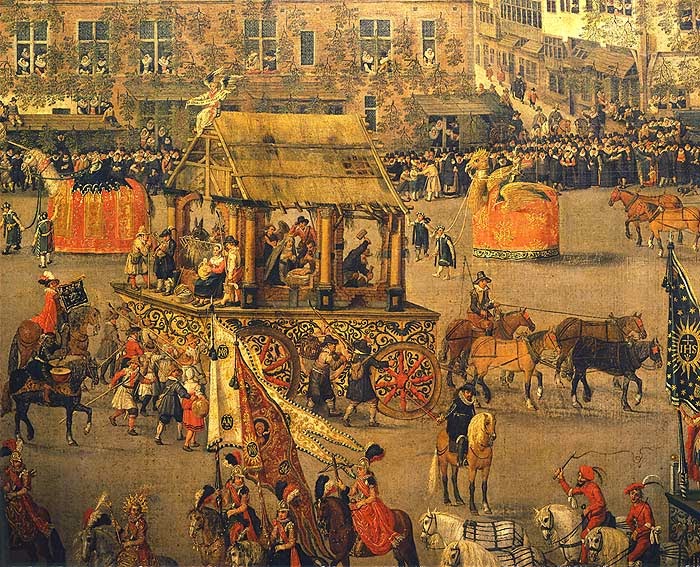Medieval Theatre.

The Church's role.
Practically everyone in medieval England 1000-1450 AD was a christian. The church played an enormous part in the lives of everyone - tiny villages would have churches and revered priests.
The church preached the bible but it was only written in Latin at this time, a language very few people could understand. To convey the meaning of the bible to those who were not learned, church services used theatre. The priest would read sections of the bible whilst actors performed them on a raised dias at the front of the church.
This worked well as it allowed the message of christianity to be spread far and wide and be accessible to everyone. However, overtime the message of these performances became skewed. In the same way that Chinese whispers are altered as they pass round the chain, the bible stories told by word of mouth between churches became subtly (and then all together) changed.
Once the heads of the church realised how altered the stories had become, they were quick to introduce a ban on the use of theatre to convey god's message. They did too little too late though and by popular demand, miracles and morality plays were introduced.
The Guilds take over.
Rather than have the church put on plays revolving around the bible, the guilds took it upon themselves to keep telling the religious stories in the form of theatre. Guilds were like unions of tradesmen. There would have been a carpenter guild and a blacksmith guild and so on.
Each guild would have an associated story they specialised
in telling, often this was closely related to their profession. For example the
guild of carpenters specialised into the story of Noah and the Ark while the bakers were associated with the last supper.
To perform these plays, the guilds funded large elaborate
caravans that rolled up and down the streets with the play being cycled over and
over on repeat. Just as the guild became associated with these performances,
different areas of London and the surrounding towns also became affiliated with
one play.

Mystery, Morality and Miracle plays.
The plays performed by the guilds all revolved around certain stories in the bible - usually from the old testimont. These stories almost always set out to explain things (clear links to early and Greek theatre). This meant they were called mystery plays, they tried to explain the mysteries of the world. One example of this is the story of Adam and Eve.
Overtime the mystery plays became less and less religous and their links to the bible became strained. This lead to the birth of morality plays.
Morality plays had strong religous themes but they did not directly revolve around bible stories. Instead they were written to include a clear moral message, one example of a mediveal morality play is Everyman. The message involved is that death is eternal and inescapable and that nothing can be taken with you after death. The morality pkays would also be performed by travelling guild wagons.
Later, as morality and mystery developed in popularity across the country, a third type of medieval play was born: miracle plays. Miracle plays followed the story of a saint‘s life and deeds. In many ways this made them like a hybrid of morality and miracle plays because they had strong links to the bible whilst also having an underlying theme.
Lots of the time these plays followed the story of a made up saint or embellished the story of a real saint beyond recognition. An exmaple of a miracle play like this was St John the Hairy who seduces and murders a princess in the opening scene.